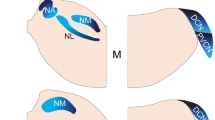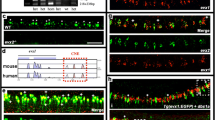Abstract
Pax genes are important modulators of CNS development. Pax7 and Pax6 polarise the neural tube and regionalise the brain. Pax7 is pivotal in specifying the superior colliculus/tectum, an important centre for integration of visuomotor responses and a target for Pax6 + retinal ganglion cell axons during retinocollicular mapping. Whilst initial Pax7-specification of the mesencephalon is well-established, a role in regulating polarity within the maturing mouse superior colliculus is yet to be defined, although already detailed for the chick tectum. We therefore quantified Pax7 cellular distribution and expression levels at three functionally distinct stages of superior collicular development, and analysed Pax7 expression in response to aberrant axonal input and altered forebrain/midbrain boundary placement in Pax6 mutant mice. Comparative expression profiles of ephrin-A2 and its co-localisation with Pax7 were determined in wildtype and Pax6 mutant mice. Results indicate that graded Pax7 expression in wildtype mice is perturbed in Pax6 mutant mice; changes manifest as a shift in polarity, loss of graded expression and dramatically reduced protein levels during RGC synaptogenesis. Ephrin-A2 expression is similarly altered. These results implicate Pax7 as an important determinant of polarity within the mouse superior colliculus, and suggest a role in retinotopic mapping.


Similar content being viewed by others
References
Agarwala S, Sanders TA, Ragsdale CW (2001) Sonic Hedgehog control of size and shape in midbrain pattern formation. Science 291:2147–2150
Basch ML, Bronner-Fraser M, Garcia-Castro MI (2006) Specification of the neural crest occurs during gastrulation and requires Pax7. Nature 441:218–222
Bunt SM, Lund RD, Land PW (1983) Prenatal development of the optic projection in albino and hooded rats. Dev Brain Res 6:149–168
Chalepakis G, Stoykova A, Wijnholds J, Tremblay P, Gruss P (1993) Pax: gene regulators in the developing nervous system. J Neurobiol 24:1367–1384
Coggeshall RE, Lekan HA (1996) Methods for determining numbers of cells and synapses: a case for more uniform standards of review. J Comp Neurol 364:6–15
Cowan WM (1971) Studies on the development of the avian visual system. UCLA Forum Med Sci 14:177–222
Cowan WM, Fawcett JW, O’Leary DDM, Stanfield BB (1984) Regressive events in neurogenesis. Science 225:1258–1265
Deiner MS, Sretavan DW (1999) Altered midline axon pathways and ectopic neurons in the developing hypothalamus of Netrin−1 and DCC-deficient mice. J Neurosci 19:9900–9912
DeLong GR, Coulombre AJ (1965) Development of the retinotectal projection in the chick embryo. Exp Neurol 13:351–363
DeLong GR, Sidman RL (1962) Effects of eye removal at birth on histogenesis of the mouse superior colliculus: An autoradiographic analysis with tritiated thymidine. J Comp Neurol 118:205–219
Edwards MA, Schneider GE, Caviness VS Jr (1986) Development of the crossed retinocollicular projection in the mouse. J Comp Neurol 248:410–421
Ericson J, Morton S, Kawakami A, Fujisawa H (1996a) Two critical periods of sonic hedgehog signalling required for the specification of motor neuron identity. Cell 87:661–673
Ericson J, Rashbass P, Schedl A, Brenner Morton S, Kawakami A, van Heyningen V, Jessell TM, Briscoe J (1996b) Pax6 controls progenitor cell identity and neuronal fate in response to graded Shh signaling. Cell 90:169–180
Feldheim DA, Kim YL, Bergemann AD, Frisen J, Barbacid M, Flanagan JG (2000) Genetic analysis of ephrin-A2 and ephrin-A5 shows their requirement in multiple aspects of retinocollicular mapping. Neuron 25:563–574
Gilbert SF (2003) Developmental biology. Sinauer Associates, Inc, Sunderland
Godement P, Salaun J, Imbert M (1984) Prenatal and postnatal development of retinogeniculate and retinocollicular projections in the mouse. J Comp Neurol 230:552–575
Goulding MD, Lumsden A, Gruss P (1993) Signals from the notochord and floor plate regulate the region-specific expression of two Pax genes in the developing spinal cord. Development 117:1001–1016
Hill RE, Favor J, Hogan BLM, Ton CCT, Saunders GF, Hanson IM, Prosser J, Jordan T, Hastie ND, van Heyningen V (1991) Mouse Small eye results from mutations in a paired-like homeobox-containing gene. Nature 354:522–525
Jay MF, Sparks DL (1984) Auditory receptive fields in primate superior colliculus shift with changes in eye position. Nature 309:345–347
Jostes B, Walther C, Gruss P (1991) The murine paired box gene, Pax7, is expressed specifically during the development of the nervous and muscular system. Mech Dev 33:27–38
Kawakami A, Kimura-Kawakami M, Nomura T, Fujisawa H (1997) Distributions of Pax6 and Pax7 proteins suggest their involvement in both early and late phases of chick brain development. Mech Dev 66:119–130
Knoll B, Isenmann S, Ertugrul K, Walkenhorst J, Engel S, Wehinger J, Bahr M, Drescher U (2001) Graded expression patterns of ephrin-As in the superior colliculus after lesion of the adult mouse optic nerve. Mech Dev 106:119–127
Lund RD, Bunt AH (1976) Prenatal development of the central optic pathways in the albino rats. J Comp Neurol 165:247–274
Marin O, Blanco M, Nieto M (2001) Differential expression of Eph receptors and ephrins correlates with the formation of topographic projections in primary and secondary visual circuits of the embryonic chick forebrain. Dev Biol 234:289–303
Marquardt T, Ashery-Padan R, Andrejewski N, Scardigli R, Guillemot F, Gruss P (2001) Pax6 is required for the multipotent state of retinal progenitor cells. Cell 105:43–55
Mastick GS, Davis NM, Andrews GL, Easter Jr SS (1997) Pax−6 functions in boundary formation and axon guidance in the embryonic mouse forebrain. Development 124:1985–1997
Matsunaga E, Araki I, Nakamura H (2000) Pax6 defines the di-mesencephalic boundary by repressing En1 and Pax2. Development 127:2357–2365
Matsunaga E, Araki I, Nakamura H (2001) Role of Pax3/7 in the tectum regionalization. Development 128:4069–4077
Nomura T, Kawakami A, Fujisawa H (1998) Correlation between tectum formation and expression of two PAX family genes, PAX7 and PAX6, in avian brains. Dev Growth Differ 40:485–495
Philips GT, Stair CN, Lee HY, Wroblewski E, Berberoglu MA, Brown NL, Mastick GS (2005) Precocious retinal neurons: Pax6 controls timing of differentiation and determination of cell type. Dev Biol 279:308–321
Rees A (1996) Sensory Maps: Aligning maps of visual and auditory space. Curr Biol 6:955–958
Schwarz M, Alvarez-Bolado G, Dressler G, Urbanek P, Busslinger M, Gruss P (1999) Pax 2/5 and Pax6 subdivide the early neural tube into three domains. Mech Dev 82:29–39
Scicolone G, Pereyra-Alfonso S, Brusco A, Peccisaavedra J, Flores V (1995) Development of the laminated pattern of the chick tectum opticum. Int J Dev Neurosci 13:845–858
Seale P, Ishibashi J, Scime A, Rudnicki MA (2004) Pax7 is necessary and sufficient for the myogenic specification of CD45+:Sca1+ stem cells from injured muscle. PLoS Biol 2:664–672
Stoykova A, Gruss P (1994) Roles of Pax-genes in developing and adult brain as suggested by expression patterns. J Neurosci 14:1395–1412
Stoykova A, Fritsch R, Walther C, Gruss P (1996) Forebrain patterning defects in Small eye mutant mice. Development 122:3453–3465
Stoykova A, Gotz M, Gruss P, Price J (1997) Pax6-dependent regulation of adhesive patterning, R-cadherin expression and boundary formation in developing forebrain. Development 124:3765–3777
Thomas M, Lazic S, Beazley L, Ziman M (2004) Expression profiles suggest a role for Pax7 in the establishment of tectal polarity and map refinement. Exp Brain Res 156:263–273
Thomas M, Beazley L, Ziman M (2006a) A multiphasic role for Pax7 in tectal development. Exp Brain Res 169:266–271
Thomas MG, Barker RA, Beazley LD, Ziman MR (2006b) Pax7 expression in the adult rat superior colliculus following optic nerve injury. Neuroreport (in press)
Walther C, Gruss P (1991) Pax-6, a murine paired box gene, is expressed in the developing CNS. Development 113:1435–1449
Xu P-X, Woo I, Her H, Beier DR, Maas RL (1997) Mouse Eya homologues of the Drosophila eyes absent gene require Pax6 for expression in lens and nasal placode. Development 124:219–231
Ziman M, Rodger J, Lukehurst S, Hancock D, Dunlop S, Beazley L (2003) A dorso-ventral gradient of Pax6 in the developing retina suggests a role in topographic map formation. Dev Brain Res 140:299–302
Acknowledgments
The authors gratefully acknowledge Dr Meghan Thomas and Carole Bartlett for expert technical assistance. The Pax7 monoclonal antibody developed by Atsushi Kawakami was obtained from the Developmental Studies Hybridoma Bank developed under the auspices of the NICHD and maintained by the University of Iowa, Department of Biological Sciences, Iowa City, IA 52242. We thank Dr Paul Rigby and John Murphy for assistance with confocal imaging (at the Centre for Microscopy and Microanalysis/Biomedical Image and Analysis Facility), The University of Western Australia, supported by funding from University, State and Federal Government and Lotterywest.
Author information
Authors and Affiliations
Corresponding author
Rights and permissions
About this article
Cite this article
Thompson, J.A., Lovicu, F.J. & Ziman, M. Pax7 and superior collicular polarity: insights from Pax6 (Sey) mutant mice. Exp Brain Res 178, 316–325 (2007). https://doi.org/10.1007/s00221-006-0735-9
Received:
Accepted:
Published:
Issue Date:
DOI: https://doi.org/10.1007/s00221-006-0735-9




